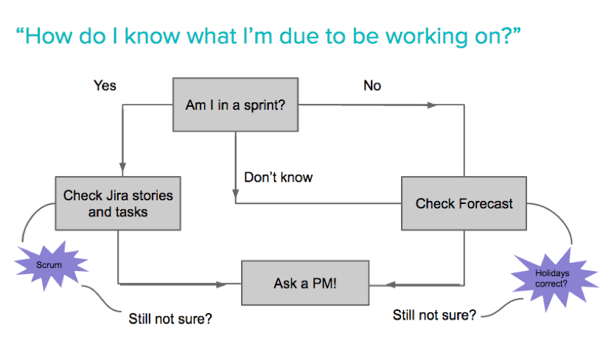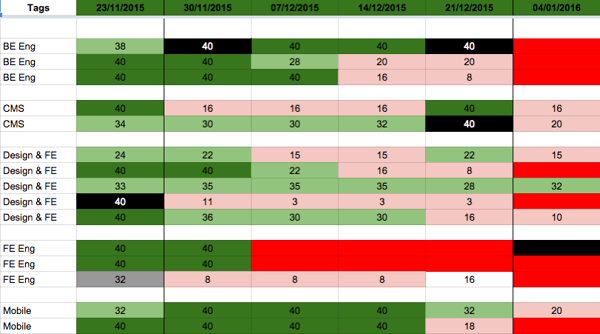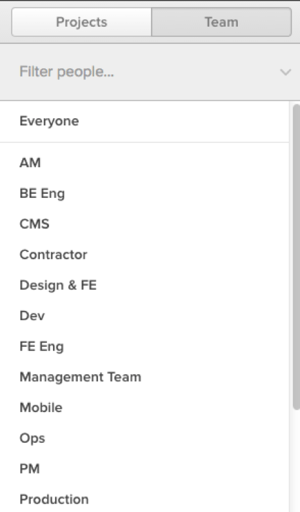Forecast makes it easy to schedule your team on multiple projects and plan out what you’re working on over the next few months. But it’s much more than a visual team calendar. It provides you with the insight to answer critical questions about your business: What is the team working on right now? Who’s under water? Do you have the capacity to take on new work? How secure is the future of the business?
In this post, Holly Davis, a project manager at White October, describes how her digital agency implemented Forecast and used it to help manage their business.
Resourcing for a growing agency is a big challenge. Things change from minute to minute and everyone has different information they need access to:
- The whole team needs to know what they’re supposed to be working on.
- Project managers need to ensure that resourcing forecasts mirror the needs of their upcoming project work.
- Account managers need long-term forecasting so they know what new business they should pursue.
A year ago we were struggling to fulfill these needs, mainly due to the fact that we had little confidence that the data we were putting in was an accurate reflection of ‘reality.’
One of our project managers, Sarah Clarke, decided to take on the challenge of improving resourcing at White October. She chose Harvest Forecast, integrated with our main Harvest account, as the management tool.
Note that the word ‘improve’ is important here as many of us had high expectations that Sarah would be able to quickly fix all of our resourcing woes. But with resourcing it’s not a simple case of finding a fix and then it just works. It’s a job with no end, an ongoing process that takes continual time, energy, and collaboration.
Here’s how Sarah implemented Forecast and how it works in practical terms:
Getting Started
Sarah began by carefully explaining how Forecast would fit into the agency’s processes and what we could all expect. This graph illustrates how we integrated Forecast into our workflow:

Sarah made sure everyone was aware of the role they played in improving our resource process and for the first time expectations were clear.
We all knew that we should:
- Look ahead a week or so to have an idea of what’s coming up
- Give project managers notice of any holidays or days out
- Flag a project manager if Forecast doesn’t match what we’re working on
This change in approach has been fundamental to the success and roll out of Forecast.
Ongoing Resourcing
To keep us all informed and involved, Sarah provides a weekly long-term resourcing update of the next seven or eight weeks. The report groups team members by the tech team they work within. This makes it easy for account managers to spot any gaps and lets them know what type of business they need to work on winning over those weeks.
Here’s what the report would typically look like:

Key:
- Dark green = full capacity
- Light green = 50-99% busy
- Light red = less than 50% busy
- Dark red = under capacity
At a glance, we can see that the front-end engineering team is light and the back-end engineering team will require more work at the start of 2016. We can also see the team members who are over capacity, which provokes conversations about how we can balance projects more evenly among the teams.
For team members who are under capacity, we use this weekly meeting to either allocate any billable work they can take on or identify some non-billable work or learning and development activities which will benefit the individual and the agency.
Sarah also attends our daily design scrum and a weekly meeting with account managers to look at qualified leads. This gives her full visibility into our current capacity, improving how projects are allocated and ensuring any timescales provided to prospective clients are realistic.
Our Favourite Features
We can’t end without giving a roundup of the features we love most about Forecast:
Color tagging
It’s really useful to be able to assign different colors to different activities. We use the following colors to help separate billable work from internal and non-billable activities, and distinguish work that’s been signed off on from placeholder work:
- Billable project work = orange
- Support work = green
- Internal activities e.g. line management, marketing = blue
- Placeholders, used by account managers to book people for work which is very likely to land = grey
- Learning = pink

Filters
We have different tech teams at White October, and therefore use the filter functionality to allocate people into their relevant tech team. We can then filter by each team which provides another useful view. It’s also really easy to temporarily add people to a different tech team if they’re helping out a different team short term.

Notes
Notes are particularly useful for team members. We tend to add the Jira issue ID or a brief description with the person to contact for more information about the task.
We also add notes to placeholder time so people can see who the prospective client is.
Top Tips
If you’re struggling to get resourcing working well in your agency, here are our top tips:
- Allocate time to a named individual to own resourcing. Sarah treats resourcing as a project and is allocated up to four hours a week in her schedule to focus on this.
- Review company meetings that could benefit from a “resource” representative, i.e. account manager meetings, design scrums.
- Block time in your calendar to review resourcing regularly. If you chip away at it every day it’s much easier to keep on top of.
- Get everyone on board. Communicate how you’re planning to use your tool and why it’s important for people to engage with it.
Key Benefits
Our transition to Forecast has happened over the last six months. When we began it was only really the account managers and project managers who looked at it regularly, but now everyone in the company goes into it almost daily.
This transition has yielded huge benefits to the company and to the way we work. Importantly, team members are now taking ownership of their own schedules. They know that it’s their responsibility to make sure what they’re working on is in Forecast and flag a project manager if they have some spare capacity.
This type of thinking is making us more efficient, and making the task of resourcing much more fluid.
How do you manage resourcing in your workplace? We’d love to hear how other people are creatively tackling the challenges it brings.
Holly Davis is a digital project manager and certified scrum master at the award-winning digital agency White October. Holly also cofounded the Oxford meetup DO PM and The Big DO learning event. In her spare time she likes to blog on Medium. You can also follow her on Twitter @ProjectDavis.
Interested in trying Forecast? Learn more or sign up for a 30-day free trial. Interested in sharing your story with the Harvest and Forecast community? Get in touch about writing a guest post.















